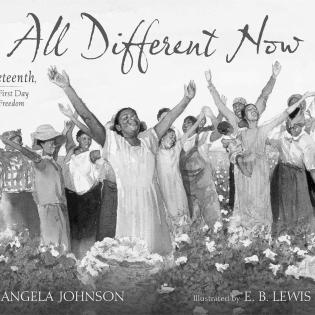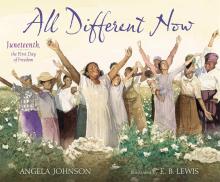All Different Now Literature Guide
Core Philanthropy Theme: As a community, we love and support one another through hard times and celebrations. As a nation, we celebrate the different experiences of our people and seek to build a better world for all.
Before Reading
Note: For those discussing this topic with K-3 students and newcomers to the USA, you may need to provide to background information about slavery before 1865.
Ask: Read the title of the book. When things are all different, what does that mean?
Show: Look at the cover and talk about the emotions being expressed by the people. What do you think the smiles and raised arms mean? Talk about what the promise of the end of slavery meant for African Americans in 1865.
Connect: Talk about a time in your life when things really changed for you. Did you get a new sibling? Did you move? When things were different, was everything all good or all bad?
During Reading
Ask: We know something big is happening, but the story begins with everything the same. Look closely at the pictures. Describe the day and the mood at the beginning of the book.
Show: Pause at the pages where the news is spreading. What do you notice? How would you describe the way people are reacting?
Connect: When the narrator says they ate, laughed, and told stories as free people, what does it remind you of? What do you think it would feel like to do things as a free person after being enslaved?
After Reading
Ask: At the end of the book, the morning begins the same as other mornings, but "all is different now." How do you think the girl sees things differently at the end? What are your thoughts about the final picture? What do you think is happening and why?
Show: Look at the dates at the end of the book and read about the messy history of freedom from slavery. Freedom from slavery didn't happen overnight. In many ways, the history of slavery is still hurting us. Telling important stories of our past helps us heal.
Connect: Maybe you celebrate Juneteenth or other holidays. What are some ways you celebrate the milestones of your people? What does that mean to you?
Activities
- Join a Juneteenth celebration in your community.
- Learn about the cultures of people in your classroom and community. Read books and be curious about traditions of people who are different than you.
- Make a poster featuring a quote about the importance of justice and freedom for everyone.
- Learn about the history of Juneteenth. Here is a resource: Smithsonian Juneteenth Digital Toolkit
- Juneteenth has been celebrated in African American communities since 1866. Juneteenth is the newest U.S. federal holiday. Read what the White House proclaimed. President Joseph Biden proclaimed June 19 a federal holiday in 2021, highlighting the importance of Juneteenth to everyone in the U.S. What are your thoughts about why it took so long (1865 to 2021) to truly recognize the importance of Juneteenth?
- Read another book about historical African American people. The Undefeated by Kwame Alexander is a poem to celebrate the creativity, perseverance, grit and impact of Black Americans on the history of the United States of America. It is both a call to action and a reminder to all that we must never give up.

